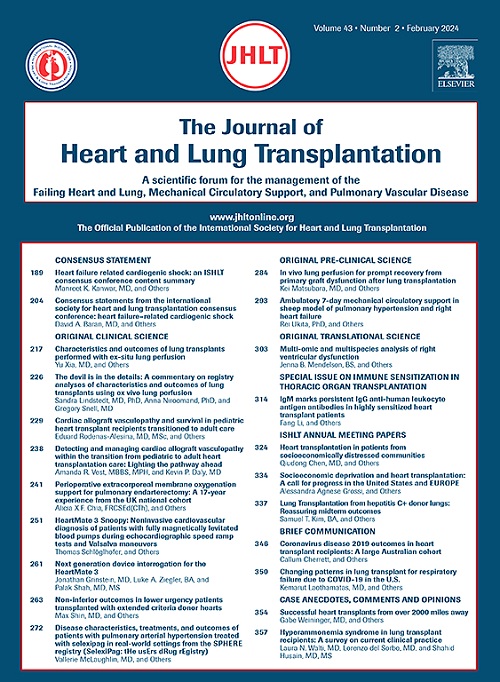双管 Impella 交换器:不间断机械循环支持的可靠方法。
IF 6
1区 医学
Q1 CARDIAC & CARDIOVASCULAR SYSTEMS
引用次数: 0
摘要
传统的 Impella 交换在将新装置推进主动脉瓣之前将旧装置拉入主动脉时会中断血流,导致循环衰竭和左心室通路丧失。在 "双管 "不间断 Impella 交换中,新装置与旧装置一起放入心室,血流首先在这里完全转换。在连续接受这种手术的 31 名患者中,没有人在术中发生心脏骤停,96.8%(30/31)的患者没有出现新的主动脉瓣关闭不全。术前已知的髂骨损伤引发了一起血管并发症。一名患者发生非栓塞性中风,另一名患者发生蛛网膜下腔出血。55%(17/31)的患者存活,其中 22.6%(7/31)康复,25.8%(8/31)接受移植,6.5%(2/31)转为耐用型 LVAD。纯Impella存活率(83.3%,10/12)显著高于Impella-ECMO存活率(36.8%,7/19)(OR 14.46,95% CI 1.74-119.93,P=0.01)。我们的结论是,"双管 "技术在设备依赖性心源性休克患者中是可靠的,优势明显,风险极低。本文章由计算机程序翻译,如有差异,请以英文原文为准。
The double barrel Impella exchange: A reliable method for uninterrupted mechanical circulatory support
Classic Impella exchange interrupts flow when the old device is pulled into the aorta before advancing the new device across the aortic valve, threatening circulatory collapse and loss of left ventricular access. In “double barrel,” uninterrupted Impella exchange, the new device is placed into the ventricle alongside the old, where flow is first transitioned completely. Of 31 consecutive patients undergoing this procedure, none experienced intraoperative cardiac arrest, and 96.8% (30/31) had no new aortic insufficiency. One vascular complication ensued following known preoperative iliac injury. One patient suffered nonembolic stroke; another had subarachnoid hemorrhage. Fifty-five percent (17/31) of patients survived, with 22.6% (7/31) recovering, 25.8% (8/31) undergoing transplant, and 6.5% (2/31) transitioning to durable left ventricular assist device. Impella-only survival (83.3%, 10/12) was significantly higher than Impella-extracorporeal membrane oxygenation survival (36.8%, 7/19; (operating room) OR 14.46, 95% ((confidence interval) CI 1.74-119.93, p = 0.01). We conclude the “double barrel” technique is reliable in device-dependent cardiogenic shock patients, offering significant advantages and minimal risk.
求助全文
通过发布文献求助,成功后即可免费获取论文全文。
去求助
来源期刊
CiteScore
10.10
自引率
6.70%
发文量
1667
审稿时长
69 days
期刊介绍:
The Journal of Heart and Lung Transplantation, the official publication of the International Society for Heart and Lung Transplantation, brings readers essential scholarly and timely information in the field of cardio-pulmonary transplantation, mechanical and biological support of the failing heart, advanced lung disease (including pulmonary vascular disease) and cell replacement therapy. Importantly, the journal also serves as a medium of communication of pre-clinical sciences in all these rapidly expanding areas.

 求助内容:
求助内容: 应助结果提醒方式:
应助结果提醒方式:


